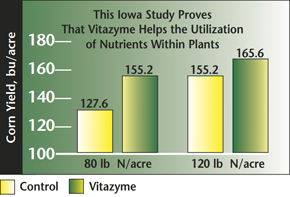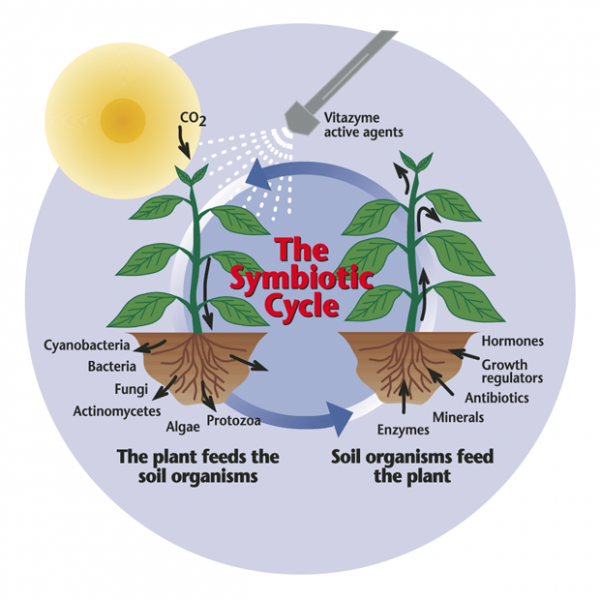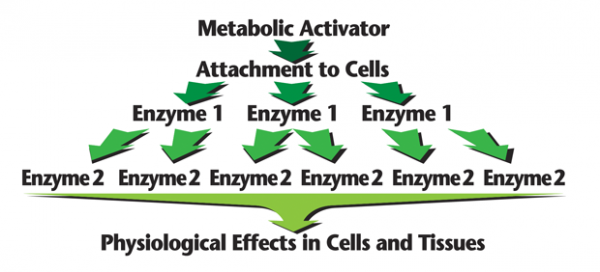Why Use Vitazyme
Vitazyme is a liquid concentrate microbially synthesized from plant materials and then stabilized for long life. Powerful but natural biostimulants contained in the material greatly benefit plant growth and soil conditions to boost growth and profits for the grower.
Vitazyme is non-toxic. It is organic, safe, and sustainable and has an array of active agents, including:
Known Ingredients in Vitazyme (all derived from natural materials):
| Brassinosteroids | 0.022mg/ml |
| 1-triacontanol | 0.33 ug/ml |
| Vitamin B1 (thiamin) | 0.35 mg/100g |
| Vitamin B2 (riboflavin | 0.25 mg/100g |
| Vitamin B6 | 0.15 mg/100g |
Vitazyme is an all-natural liquid “biostimulant” for soil organisms and plants that contain certain biological activators, which are by-products of a proprietary fermentation process. These active agents include vitamins, enzymes, and other powerful but gentle growth stimulators such as B-vitamins, triacontanol, glycosides, and porphyrins.
Vitazyme, used within the context of a common-sense management system, will help the farmer overcome many of his production problems. While not a “magic bullet,” it helps the entire system work better.
Agriculture of today must emphasize the use of biological systems — not strictly chemical approaches — to achieve long-term soil productivity.
The product promotes soil life by conforming with natural laws, encouraging natural predators to control insect and nematode pests, promoting more intensive biological nitrogen fixation, and stimulating natural rhizosphere organisms to produce needed plant growth factors.
Investigations are continuing on other components:
Likely phytoactive components which will be discovered include the following:
- Various porphyrins (chlorophyll derivatives)
- Various glycosides (glucose derivatives)
- Salicylic acid or salicylates
- Amino acids such as methionine and others
- Nucleic acid remnants or precursors
- Nucleotides, especially adenine but possibly others
- Gallic acid
- Glucuronic acid
- Various enzymes
Benefits to Soils
Soil structure, so critical for air and water movement through the soil to facilitate root growth and nutrient uptake, is improved by Vitazyme in at least four ways:
- Increased root growth (more root channels).
- More polysaccharides glue particles together; only 0.2% more polysaccharides can markedly improve structure.
- Improved mycorrhizae activity (creating sac-like structures)
- Greater earthworm activity, their burrows create channels for air and water. Water infiltration is increased, and runoff and erosion are consequently decreased. Compaction is reduced so roots can freely explore the soil for nutrients and water, increasing yields.
How Vitazyme benefits Plumeria
Vitazyme will increase chlorophyll first, allowing the plumeria to harness more energy from the sun. The plumeria will develop a larger and more efficient root system and working in conjunction with the microbial population in the rhizosphere will convert more nutrients from a non-uptake able form to forms that can be taken up by the plumeria. In this way, the soil system becomes more efficient and is the main reason why we say you can lower your nutrient inputs using Vitazyme. This, in part, explains the typical results of greater yield and quality measures for any crop.
- Greater root and leaf growth
- More and bigger blossoms
- Improved soil conditions
- Inexpensive, very cost-effective
- Easy to use
- Safe and non-toxic
- Can be seed-applied
- Can be tank-mixed with any liquid fertilizers, herbicides, and pesticides
- Can run through irrigation lines without clogging


Vitazyme applied through the irrigation system–drip, sprinkler, or sprayed–will accelerate the growth and maturity of plumeria, in containers or in the ground. Trunk caliper will increase faster as photosynthesis and leaf areas are accelerated. Vitazyme will improve the roots, leaf, and flower growth.
Treated seeds will emerge faster, and seedling growth will be more vigorous. Improved chlorophyll development will give faster nutrition, deeper green colors, and more lustrous and attractive leaves. Vitazyme will also aid in the early development of flowers.
Vitazyme Science
Vitazyme intensifies the activity of the plant-soil system. Photosynthesis is increased, so more carbon from the air is fixed into plant tissue. Energy-rich compounds produced in the leaves by this vigorous metabolism move into the root system and out into the soil, or media where billions of bacteria, algae, fungi, protozoa, and other organisms feed on this energy. The organisms, in turn, release minerals and growth stimulants for plant uptake…a beautiful symbiosis. Plant stress is reduced, removing growth and yield limitations.
Vitazyme Stimulates Rhizosphere SymbiosisVitazyme contains “metabolic triggers” that stimulate the plant to photosynthesize better, fixing more sunlight energy in the form of carbon compounds to increase the transfer of carbohydrates, proteins, and other growth substances into the root zone. These active agents may enter the plant through either the leaves or the roots. Root growth and exudation are both enhanced. This enhancement activates the metabolism of the teeming population of rhizosphere organisms to a higher level, triggering a greater synthesis of growth-benefitting compounds and a faster release of minerals for plant uptake. The plant microbial symbiosis is stimulated. |
 |
The Enzyme Cascade EffectVery small amounts of these metabolic triggers in Vitazyme are needed to greatly improve plant and rhizosphere microbe response. This is because of the enzyme cascade effect. Successive tiers of enzymes are activated in plant and microbial tissues to yield a large physiological response from a very little applied activator. In short, Vitazyme enables the plant to better express its genetic potential by reducing the stresses that repress that expression. |
 |
Improved Symbiosis: The Secret of Vitazyme’s Action
All plants that grow in soils develop an intimate relationship between the roots and the organisms that populate the root zone. The teeming billions of bacteria, fungi, algae, cyanobacteria, protozoa, and other organisms that grow along the root surfaces—the rhizosphere—are much more plentiful than in the bulk of the soil. This is because roots feed the organisms with dead root epidermal cells as well as compounds exuded from the roots themselves. The plant may inject up to 25% or more of its energy, fixed in the leaves as carbohydrates, amino acids, and other compounds, into the root zone to feed these organisms… for a very good purpose.
The microorganisms which feed on these exuded carbon compounds along the root surfaces benefit the plant in many ways… a beautiful symbiotic relationship.
The plant feeds the bacteria, fungi, algae, and other microbial species in the rhizosphere, which in turn secrete enzymes, organic acids, antibiotics, growth regulators, hormones, and other substrates which are absorbed by the roots and transported to the leaves. The acids help dissolve essential minerals, and reduced iron releases anionic elements.
A few important microbe groups are listed below.
 |
Mycorrhizae, especially vascular-arbuscular (VAM) tyes, form “arbuscules” within root cortical cells and extend thread-like hyphae into the soil, increasing the root feed surface by ten times or more. They are the major means for uptake of phosphorus, copper, zinc, and other less mobile elements. They also can extract water under much drier conditions than can root plants. |
 |
Cyanobacteria fix carbon (they photosynthesize), and also fix nitrogen from the air for plant use. |
 |
Phosphate-dissolving bacteria excrete acids that dissolve minerals and release hard-to-get phosphorus. |
 |
Azotobacter species live on exudates and other carbon sources while fixing nitrogen. |
 |
Actinomycetes generate a variety of pathogen-fighting antibiotics. |